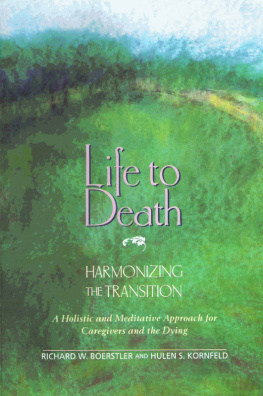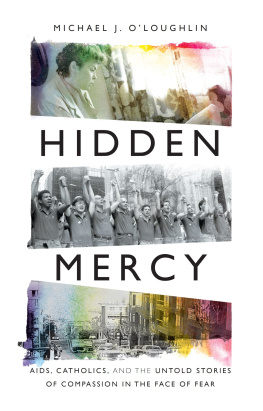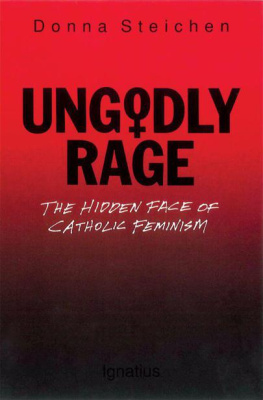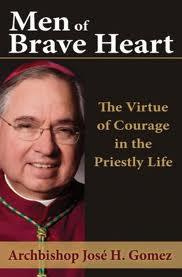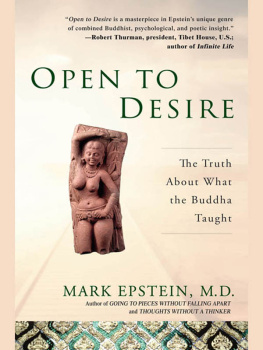Copyright 2012 Fordham University Press
All rights reserved. No part of this publication may be reproduced, stored in a retrieval system, or transmitted in any form or by any meanselectronic, mechanical, photocopy, recording, or any otherexcept for brief quotations in printed reviews, without the prior permission of the publisher.
Fordham University Press has no responsibility for the persistence or accuracy of URLs for external or third-party Internet websites referred to in this publication and does not guarantee that any content on such websites is, or will remain, accurate or appropriate.
Fordham University Press also publishes its books in a variety of electronic formats. Some content that appears in print may not be available in electronic books.
Library of Congress Cataloging-in-Publication Data
Giannone, Richard.
Hidden: reflections on gay life, AIDS, and spiritual desire/Richard
Giannone.1st ed.
p. cm.
ISBN 978-0-8232-4184-2 (cloth: alk. paper)
1. Giannone, Richard. 2. Catholic gay menNew YorkNew YorkBiography. 3. Care of the sick. 4. CaringReligious aspectsCatholic Church. I. Title.
BX4705.G525A3 2012
282.092dc23
[B]
2011047353
Printed in the United States of America
14 13 12 5 4 3 2 1
First edition
1
An Unfurnished Life
Truly, you are a God who hides himself.
Isaiah 45:15
Chance has determined the most important things of my life. The coming of a stranger was a telling instance of a rewarding accident that I couldnt have imagined. His appearance held an advantage to be snatched from lucky chances. His guy-next-door good looks, his affecting personal story, his simplicity, his gentle disposition and spiritual desireit was all entirely improbable. Improbable, also, that I would entrust my hearts secrets and place my future plans in him.
He came in 1981, just in the nick of time. I was forty-seven. Ill save your doing the math; I am now closing in on seventy-five, appreciatively beyond the threescore and ten allotted in the Psalms. His arrival began a friendship that was the great blessing of my life. And I am haunted by the fear that I will forget how cut off I was before this man broke into my buffered existence. Remembering such a favor helps protect me from the hits of aging that could entrap me anew.
Back then I stayed home most of the time at my desk, reading, correcting student essays, or hunching over a Smith-Corona electric typewriter, pecking away without concentration. Stacks of books, many unread, awaited sorting. A few pieces of thrift-shop furniture scattered on a threadbare cranberry-red tribal rug from Lake Van in eastern Turkey equipped the place, a container for thought. A friend once commented that my three rooms seemed to be waiting for someone to occupy them. At the very least, my spirit needed refurbishing. In the 1970s and 80s being gay didnt evoke, as it presently does, a shrug of the shoulders. Gay life in those decades was menaced by shame and therefore essentially concealed. Even some of those who were not openly homophobic held homosexuals in wary disdain.
Anxiety about getting sick and dying had locked me into fearful self-concern that verged on emotional shutdown. Life as I knew it and hoped it would be was dying out as a fusillade of deadly organisms stealthily attacked gay men. Swollen lymph nodes, signs of infections, popped up during routine physical examinations. In the spring of 1981 five young men in Los Angeles came down with pneumonia from the cytomegalovirus, the herpes virus that usually resolves on its own but was life-threatening in these men. Parasitic pneumonias associated with Third World countries and rare skin tumors ordinarily found in elderly Mediterranean men were appearing in clusters of healthy young gay men in San Francisco and New York. The final quarter of the twentieth century unleashed strange agents of physical dread.
Extinction shrouded gay life. Death wore a public face. Like police raiding a gay bar, the disease outed even the most closeted gay men with a stigmatizing sweep. Private lives became public issues. A cold twilight had settled on my life and the people around me. I might say, with only slight risk of overstatement, that I was growing unaccustomed to being with people. To live happy, goes a French saying, live hidden. Well, I settled just to live.
With all its resources and expertise, medical science remained clueless about the cause of these malignancies until 1983, when Luc Montagnier at the Pasteur Institute in Paris identified a suspect virus. Later that year Anthony Gallo at the National Cancer Institute in Washington cultivated the virus for further investigation and human testing. The cause of these opportunistic diseases of the old and undeveloped places, now atypically presented in urban young men, was found and dubbed AIDS. The name has always struck me as a speciously friendly acronym for so mortal an enemy. Plague, scourge, pestilence, and contagion work better. It was a gnarly pathogen that kept developing new strains. Research offered a dim hope for treatment and cure.
Epidemic disease of high mortality is not specific to a certain time or place. Neither is sexual desire mixed with distress a new form of torment. HIV/AIDS is current history and an old story at the same time. My experience similarly combines recent events with past disturbances.
As AIDS spread, the disease became an emblem of rampant evil. Laws across the country singled out people with the affliction. The knowing transmission of HIV was a crime in many states. Failure to disclose ones medical status to a partner meant prosecution. Cuba had detention camps for people suffering from the disease. Stigma was criminalized. To emphasize the public slaying endured by sufferers, some political crusaders replaced the neutral clinical language of dying from AIDS with the nuclear killed by AIDS. It was a massacre. Hate reigned. Though little about the syndrome was understood, much was felt and suffered at the very vortex of human desire and need. Sexual intimacy was a minefield of damaging effects yet to be born. Fear charged even the little things of mundane life. Contact with body fluids was like touching a plutonium trigger.
Psychological depth charges exploded firmly implanted anxieties in me. Low-lying dreads went beyond sexual hookups with other men to my essential human identity. My personal experience in the New York gay subculture gave me good reason to be vigilant about safety. Sex in the city during the volcanic late 1960s and 1970s, for all the nostalgic celebrations, was not an HBO series of spiffy adventures. It was combat against unseen adversaries that in retrospect presaged the AIDS crisis. A year and a half after I arrived in August 1967 at thirty-two raring to make up for missed experiences in the Midwest, the pagan in me pitched a tent in the freewheeling sensual fray.
One of the lurking enemies at the time was hepatitis B, and I contracted it. The infection almost killed me. I went to the hospital when snow was on the ground in early March 1969 and left as the sun warmed the early June air. My mother and sister celebrated Mothers Day by visiting me in the hospital. They brought pink carnations, which to them marked the love of living mothers (white flowers honored death mothers). After they asked how I was, Giannone female love moved under full steam. They opened the Venetian blinds of my hospital room to let in the sunlight. They covered their apprehension by bustling about smoothing the bed sheets and asking overcontrolling questions about the food. I wanted to say something funny.



